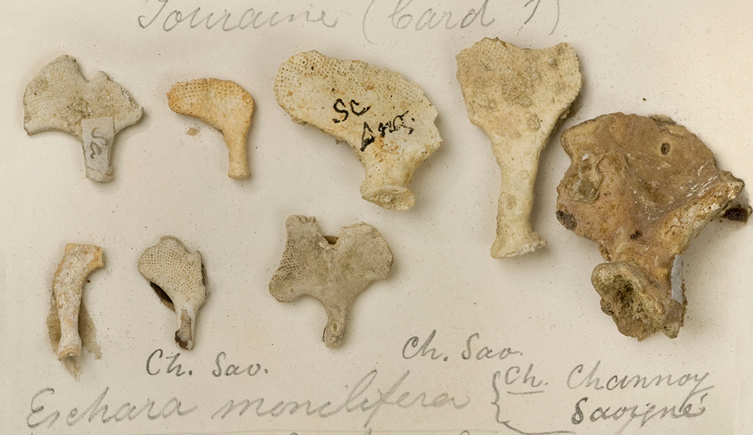
Scanning electron micrograph of zooids of Watersipora grandis, a fossil cheilostome bryozoan. The specimen originates from the Pliocene Pinecrest Beds in Sarasota, Florida, North America.
The Museum holds the best collection of fossil bryozoans in the world, with more than 5,000 type and figured specimens.
1,500,000 5,000
Specimens Type and figured specimens
Strengths
The collection contains an estimated 1,500,000 specimens, making it one of the largest palaeontology collections at the Museum.
The value of the collection is enhanced by a specialist library and more than 20,000 scanning electron microscope images.
Countries of origin
The collection is representative of all continents.
-

Fossil bryozoans from the Miocene of Touraine, France, mounted and annotated by William Lonsdale for the famous geologist Sir Charles Lyell
-

Scanning electron micrograph of Wilbertopora woodwardi (Brydone), a fossil cheilostome bryozoan. The specimen originates from the Upper Cretaceous chalk, Hampshire, UK.
Geological range
The full geological range of each group of bryozoans except the Phylactolaemata is represented:
- the class Gymnolaemata, with the following orders:
- Cheilostomata (Jurassic to Recent)
- Ctenostomata (Ordovician to Recent)
- the class Stenolaemata, with the following orders:
- Cryptostomata (Ordovician to Triassic)
- Cyclostomata (Ordovician to Recent)
- Cystoporata (Ordovician to Triassic)
- Fenestrata (Ordovician to Permian)
- Trepostomata (Ordovician to Triassic)
Looking for a specimen?
The fossil bryozoan collection is being digitised
Curator
Any questions ?
If you would like to use any specimens for research
Important historical collections
- Ulrich collection
- Arthur W Rowe collection
- Searles Wood collection
- George Busk collection
- Tesson collection
- Sir Charles Lyell collection
- J W Gregory collection
- William Lang Collection
- D A Brown collection
Related information

Collections on the move
Access to some collections will be affected as we prepare for the move to our new collections, science and digitisation centre.

Accessing the collections
Scientists and collections management specialists can visit the collections and borrow specimens for research.

Collections management
Our duty is to provide a safe and secure environment for all of our collections.